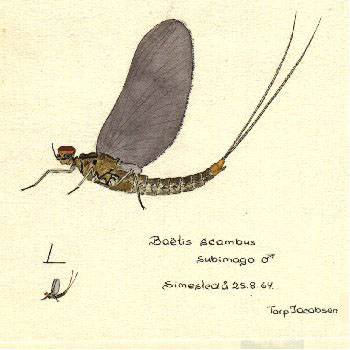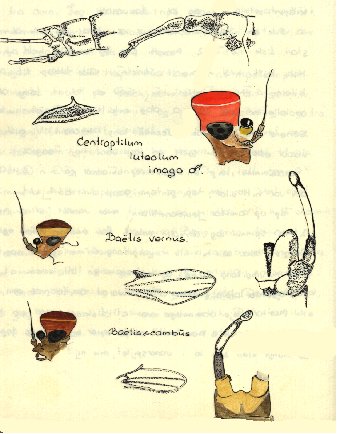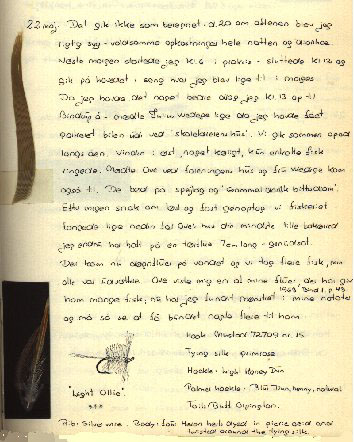A
Diary.
A
fishing diary will never find a better reader
ARTHUR RANSOME 'MAINLY
ABOUT FISHING'.
It
was not until1962 that I started writing a fly-fishing Diary. Before that time
I had made notes in diaries I have got as a Vet. Surgeon from a medical firm
in Copenhagen.
I started first after I have read Arthur Ransome's book "Mainly about Fishing",1950 - where the author recommends to write diaries.
I went to the bookbinder Haarslev in nearby Hobro, and he made a diary of 200 pages 14 x 24 cm and bound it in bordeaux- coloured oasis goat-skin. It covered the next five years and after that it has got five 'brothers' more - most often with 300 pages -then the prize for the binding is nearly the same independent of the number of pages! My good fortune was, that he recommended 'ledge paper' - calendared but absolutely no chalk - and as such I could use it with all types of writing tools and moreover if needed even use water-colours.
The pages were totally
blank without any disturbing lines etc. In the first one I myself numbered the
pages by hand; but in the later ones I abandoned that. Shall I refer to some
earlier writings then I use the dates. It has one drawback - I have to look
for the year on beforehand, then each item starts with date & month, but
the year is only written at the start of each year.
To prevent 'too much of a
hitch' I use a sort of ruler-paper, when I shall write several text-lines.
Already early in my career
as a diary-writer I used to include samples of materials for mentioned flies,
and in the last years I have moreover included samples of the flies glued to
the pages - one has to use a flexible glue that doesn't penetrate the paper
[Devcon Duco cement].
It has of course given some
problems, when I shall write on the next page. It has always been a problem to
me how to store flies given to me by friends - should I place them in separate
boxes with the tiers name enclosed or in bigger boxes together with flies from
others? Storing them in my diaries can keep them in order and moreover keep
them at a place related to the time I got them.
Should I to day let a new diary be made then I would ask the bookbinder to place narrow strips of heavy paper between the sheets of paper.
My angling diaries have changed style so to speak over the
last years: Now they are more a sort of gastronomic calendars with enclosed
etiquette's of famous wines and whiskies, and as a result of this the diaries
are showing symptoms of bursting - using an addition of heavier paper could
give them a better opportunity for 'expansion'.
Underneath I give some proofs of the ways I have used my diaries!

This is my first real
successful watercolor of a dayfly. I caught the fly on my home stream and made
the drawing and coloring shortly after at home. I have most of my experiences
in this new hobby in my diary and can by this follow the very fast progress I
made. Its the special writing/drawing with china-ink in a diary:
There is no way back done is done and the same with painting.

This is from drawings made the same year 23. August where I inspected some dayflies under a magnifying glass to see the finer details of their anatomy.

This is a special page in my diary 22. May 1971 I met one of my eldest friends, who told me, he had not any more of a dry fly I had given him years ago. I had to speculate a bit to find out after his verbal description, what fly it was. In those years we created and tied a lot of flies; but had never thought to give them names. This fact bewildered some fly fishers who met us at a stream, when they asked what fly we had caught our fish on, and we couldnt give them an answer. In their eyes we looked like pure novices not knowing the name of the flies on our casts.
Looking back in my first diary I found the recipe I had created it to my eldest son, when he started fly fishing I had equipped it with a body-hackle so that it would be easier for him to retrieve it, should it be caught in the vegetation.